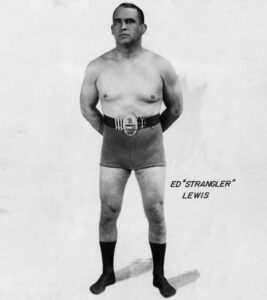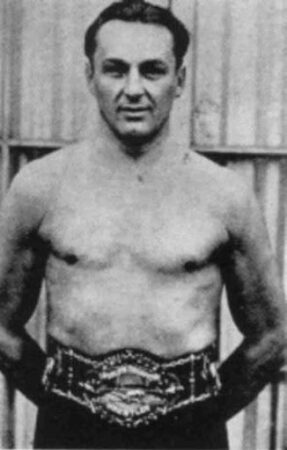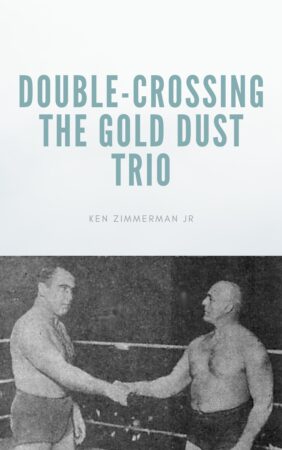Lewis i Stecher pucaju posljednji put
Dominacija Gold Dust Trija u profesionalnom hrvanju početkom do sredine 1920-ih izazvala je mnogo ljutnje kod drugih hrvača i promotora. This professional jealousy led to a famous double-cross in 1925. Od ovog vremena nadalje, naslov svjetskog prvaka bio je sporan jer je Joe Stecher držao jednu verziju, dok je Ed “Davitelj” Lewis je imao drugu verziju.
Due to the real resentment that existed between long-time rivals, a match between both men took 3 years to secure. Po Fall Guys: Barnums of Bounce od Marcusa Griffina (Amazon partnerska veza), the men agreed to a legitimate contest to unify the world title again.

Photo of “Davitelj” Lewis i Joe Stecher prije njihovog 1928 utakmica u St. Louis (Public Domain)
Fall Guys is a interesting mix of fact and fiction, so I was skeptical of this claim by Griffin. Griffin’s account would have been based on second hand information years after the event, so his account can’t be taken at face value. Međutim, after reading the detailed newspaper account in the St. Louis Post-Dispatch, I believe Griffin’s information is correct.
I drew this conclusion for a couple of reasons. The first one is the match was both long and boring. The problem with professional wrestling contests prior to the worked era is skilled wrestlers could stalemate each other, sometimes for hours. Wrestlers started cooperating with each other in worked matches to make the match more exciting and draw more fan interest. More exciting matches led to bigger audiences and more money.

I “Davitelj” Lewis with his world title belt (Public Domain)
Secondly, “Davitelj” Lewis did not use the headlock in this match. Lewis didn’t use the headlock in shoot contests because it would put him in a vulnerable position with his opponent on his back.
The men chose St. Louis under the respected promoter Tom Packs to wrestle the contest. Harry Sharpe was the agreed upon referee. The match took place on Monday, Veljača 20, 1928 in the St. Louis Coliseum.
While “Davitelj” Lewis appeared much stockier only two pounds separated the men. Lewis weighed 228. Stecher weighed 226.
The men began the match, which progressed at a snail’s pace for the next two hours. Lewis basically bullied and pushed Stecher around. Stecher’s only offense was desperate attempts to secure a leg takedown on Lewis. Griffin stated Stecher injured Lewis’ ribs with a leg scissors but Stecher actually failed in his only two attempts to secure his pet hold.
Nakon 2 hours and 16 zapisnik, Lewis was able to secure an armlock. Twisting hard, Lewis forced Stecher to go to the mat or have his shoulder seperated. Lewis was able to pin Stecher for the first fall.
The exhausted men left the ring and headed for their dressing rooms for a 20 minute intermission. At this point, the men may have agree to work the remainder of the match. Lewis had won the last legitimate contest between the men in the late 1910s. Stecher probably knew after the first fall that this match would go the same way.

Joe Stecher sa svojim prvenstvenim pojasom (Public Domain)
After the intermission, Stecher immediately secured a wristlock and unsuccessfully tried to secure a leg scissors. Međutim, Stecher didn’t release the wristlock and the men fell awkwardly to the mat. Lewis struggled for a few more seconds but conceded the fall at 54 sekundi. It was Stecher’s only real offense in the match.
The third fall began with Lewis again the aggressor. Even if they agreed to work after the first fall, Lewis wouldn’t allow himself to be put in any compromising positions in this fall.
After slamming Stecher to the mat twice with body holds, Lewis secured a double-wristlock. Lewis forced Stecher to the mat, while Stecher’s legs were clearly in the ropes. Međutim, referee Harry Sharpe did not break the men as was usual in most matches.
Lewis eventually pushed Stecher’s shoulders to the mat for the third and deciding fall. Stecher would protest his legs were in the rope to no avail.
Referee Sharpe explained to the St. Louis Post-Dispatch that he explained to Tony Stecher and Billy Sandow, Stecher’s and Lewis’ managers respectively, that he would not break for the ropes unless it was clearly interfering with the wrestler’s ability to defend himself. Joe Stecher was not attempting to bridge or defending in any way other than trying for a rope break. The referee’s decision stood.
Sharpe’s instructions about the ropes make sense as the bout definitely started out as a contest or a shoot. If the last two falls were worked as I suspect, the rope controversy would also be a classic finish to help Stecher look better to the fans as the bout finish was controversial.
U Fall Guys, both Jim Londos and Renato Gardini, skilled professional wrestlers better at working than shooting, were there to watch the contest that night. Both men thought the end of the match was worked.
Klin dizač’ training partner Joseph “Toots” Mondt continued to claim the whole match was a legitimate contest. Mondt was quoted as telling Londos and Gardini that they wouldn’t know a contest if they saw one.
The most surprising thing about the match was it only drew 7,000 fans to the Coliseum, which frequently drew between 10,000 i 12,000 fans. The gate was a reported $65,000 of which Stecher received $29,000 and Lewis received $19,000. If Stecher was going to lose his claim to the championship, he was going to be well paid for it.
What few people knew at the time was the “Davitelj” Lewis was already partially blind from the effects of trachoma, a disease he picked up from dirty wrestling canvases. U vrijeme ove utakmice, he could only see the outlines of people. Lewis was so skilled he could still beat anyone who dared try to shoot on him in the ring.
Nakon 3 godina, the world title had been unified again. Međutim, double-crosses would continue to be an issue in professional wrestling for Lewis and his successors. You always had to be careful with the huge egos in professional wrestling.
You can leave a comment or ask a question about this or any post on my Facebook page.
Sources: Fall Guys: Barnums of Bounce by Marcus Griffin and St. Louis Post-Dispatch, Veljača 21, 1928 edition, p. 24-25
Pin It

